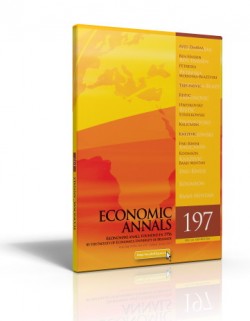THE FELDSTEIN-HORIOKA PUZZLE AND TRANSITION ECONOMIES
##plugins.themes.bootstrap3.article.main##
##plugins.themes.bootstrap3.article.sidebar##
Despina Petreska
Nikica Mojsoska-Blazevski
Nikica Mojsoska-Blazevski
Abstract
The objective of this paper is to investigate the existence of the Feldstein and Horioka puzzle in transition countries, divided into three groups of countries: South-East Europe (SEE), Central and Eastern Europe (CEE), and the Commonwealth of Independent States (CIS). Central to this puzzle is the β coefficient, which measures the relationship between domestic savings and investment. In their seminal paper from 1980 Feldstein and Horioka estimated a value of the β coefficient close to 1, which in their opinion indicates low capital mobility as opposed to the theory and the conventional wisdom of perfect capital mobility. We use annual data for the period 1991-2010 and panel cointegration econometric technique to examine this relationship in three panels of countries (SEE, CEE, and CIS). We find that the puzzle of Feldstein and Horioka exists in all three panels, but the connection between savings and investment is generally lower than 1. As we move towards a panel composed of the larger and richer countries the value of the β coefficient increases. Moreover, the coefficient of adjustment of the disequilibrium between domestic savings and investment is positive in all cases, indicating that any imbalance between savings and investment is not corrected immediately.
##plugins.themes.bootstrap3.article.details##
Keywords
Feldstein-Horioka puzzle, domestic savings, investment, capital mobility, panel cointegration, transition economies
JEL Classification
E21, F21, O16
Issue
Section
Articles
How to Cite
Petreska, D., & Mojsoska-Blazevski, N. (2013). THE FELDSTEIN-HORIOKA PUZZLE AND TRANSITION ECONOMIES. Economic Annals, 58(197), 23-46. https://doi.org/10.2298/EKA1397023P
How to Cite
Petreska, D., & Mojsoska-Blazevski, N. (2013). THE FELDSTEIN-HORIOKA PUZZLE AND TRANSITION ECONOMIES. Economic Annals, 58(197), 23-46. https://doi.org/10.2298/EKA1397023P

